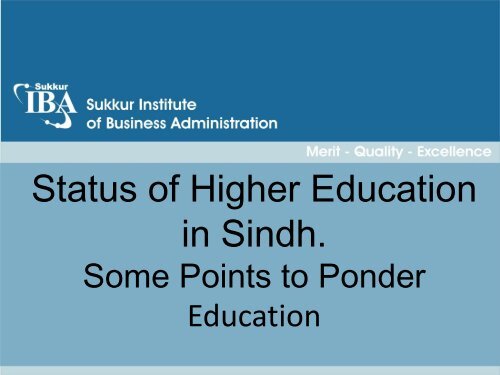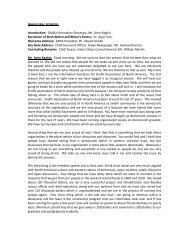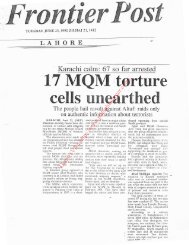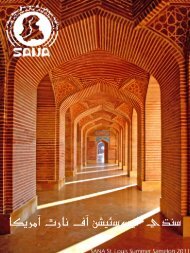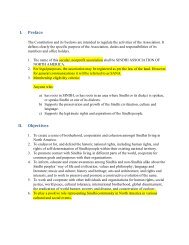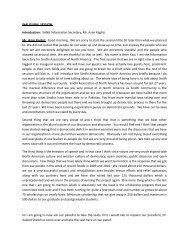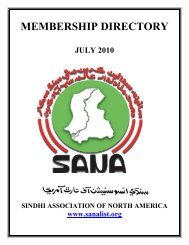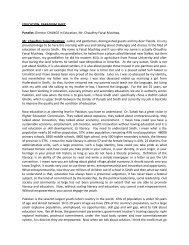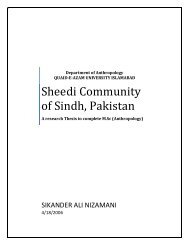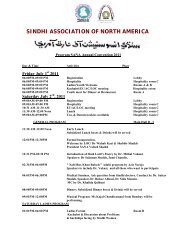Status of Higher Education in Sindh-by Nisar Siddiqui
Status of Higher Education in Sindh-by Nisar Siddiqui
Status of Higher Education in Sindh-by Nisar Siddiqui
Create successful ePaper yourself
Turn your PDF publications into a flip-book with our unique Google optimized e-Paper software.
<strong>Status</strong> <strong>of</strong> <strong>Higher</strong> <strong>Education</strong><br />
<strong>in</strong> S<strong>in</strong>dh.<br />
Some Po<strong>in</strong>ts to Ponder<br />
<strong>Education</strong>
<strong>Education</strong> & Importance<br />
• Be<strong>in</strong>g an educated person means you have access to optimal states <strong>of</strong> m<strong>in</strong>d<br />
regardless <strong>of</strong> the situation you are <strong>in</strong>.<br />
• Pakistan literacy rate 57.7%<br />
• Punjab 59.6%<br />
• S<strong>in</strong>dh 58.2%<br />
• S<strong>in</strong>dh rural only 41%<br />
•Only 20% females are educated <strong>in</strong> rural areas <strong>of</strong> S<strong>in</strong>dh. (Source : Pakistan<br />
Bureau <strong>of</strong> statistics)
Big Picture!<br />
The annual report which assessed school-go<strong>in</strong>g<br />
children, aged 3 to 16 years, from six districts <strong>of</strong><br />
rural S<strong>in</strong>dh pa<strong>in</strong>ted a worrisome picture <strong>of</strong> learn<strong>in</strong>g<br />
outcomes:<br />
32% do not go to school at all.<br />
67% <strong>of</strong> those who cannot read sentences <strong>in</strong> Urdu<br />
or S<strong>in</strong>dhi.<br />
66.5 % cannot read sentences <strong>in</strong> English.<br />
73 % cannot do two-digit subtraction sums.<br />
Source: The Express Tribune, January 29 th , 2011
S<strong>in</strong>dh <strong>in</strong> <strong>Education</strong>al Perspective<br />
• Universities (Public Sector)<br />
• Gov. <strong>of</strong> Pakistan 21<br />
• Gov. <strong>of</strong> S<strong>in</strong>dh 17<br />
• Gov. <strong>of</strong> Punjab 18<br />
• Gov. <strong>of</strong> Balochistan 6<br />
• Gov. <strong>of</strong> KPK 14<br />
• Gov. <strong>of</strong> AJK 2<br />
• Total 74<br />
Reference HEC Statistics on website
S<strong>in</strong>dh <strong>in</strong> <strong>Education</strong>al Perspective<br />
Universities (Private Sector)<br />
Gov. <strong>of</strong> Pakistan 3<br />
Gov. <strong>of</strong> S<strong>in</strong>dh 27<br />
Gov. <strong>of</strong> Punjab 19<br />
Gov. <strong>of</strong><br />
Balochistan 2<br />
Gov. <strong>of</strong> KPK 9<br />
Gov. <strong>of</strong> AJK 1<br />
Total 56<br />
Reference HEC Statistics on website
Challenges<br />
The <strong>Education</strong> sector <strong>in</strong> S<strong>in</strong>dh is faced with<br />
many challenges:<br />
• Very low enrollment.<br />
• Rural and gender disparity.<br />
• Low level <strong>of</strong> quality education.<br />
• Poor quality <strong>of</strong> teachers & managers.<br />
• Only 50% students <strong>of</strong> age 5-15 are enrolled <strong>in</strong><br />
schools.<br />
• Around 70% girls have never attended school.<br />
• Situation is grave for Mathematics and Science<br />
subjects.<br />
6
Current Scenario <strong>of</strong> <strong>Higher</strong> <strong>Education</strong><br />
•Top 1000 universities rank<strong>in</strong>g- only university <strong>of</strong> Karachi is <strong>in</strong>cluded.<br />
•S<strong>in</strong>dh economy is agricultural based. There is only one agriculture university <strong>in</strong><br />
entire s<strong>in</strong>dh but the performance and outcomes <strong>of</strong> this university are not<br />
encourag<strong>in</strong>g.<br />
•Total spend<strong>in</strong>g on higher education is 2.3% <strong>of</strong> GDP.<br />
• The age group <strong>of</strong> 17-23, who are eligible for access <strong>in</strong> higher education only 5.1<br />
% can access the higher education, where as <strong>in</strong> S<strong>in</strong>dh only 4.7% jo<strong>in</strong> the<br />
universities. (If we take out the urban centers Karachi and Hyderabad, this number<br />
will come around 2%).<br />
•The number <strong>of</strong> girls access<strong>in</strong>g higher education <strong>in</strong> S<strong>in</strong>dh is much less.<br />
•Over all research output <strong>of</strong> universities <strong>of</strong> S<strong>in</strong>dh is less.
Research Output<br />
S<strong>in</strong>dh University<br />
Punjab<br />
University<br />
KPK University<br />
95 356 153<br />
Agriculture University<br />
Tandojam<br />
Agriculture Uni.<br />
Faisalabad<br />
KPK Agriculture<br />
University<br />
11 412 106<br />
Mehran Engg Uni UET, Lahore UET, KPK NED<br />
08 78 15 15
Teachers Pr<strong>of</strong>essional <strong>Education</strong> and<br />
Development
Human Development Index<br />
Rank<strong>in</strong>g<br />
Country<br />
(Regional/Global)<br />
2010<br />
Iran 1/89<br />
Sri Lanka 2/122<br />
India 3/129<br />
Nepal 4/140<br />
Bangladesh 5/142<br />
Maldives 6/143<br />
Pakistan 7/148<br />
Afghanistan 8/159<br />
Bhutan 9/177<br />
Source: http://hdr.undp.org/en/data/trends/<br />
10
Human Development <strong>in</strong> South and West Asia<br />
(Source: Human Development Report 2007-08, and UNESCO EFA Global Monitor<strong>in</strong>g Report 2009)<br />
Country HDI Rank<strong>in</strong>g Public<br />
expenditure on<br />
<strong>Education</strong><br />
as % <strong>of</strong> GNP<br />
Literacy Rate<br />
15+ (%)<br />
India 128 3.3 65<br />
Iran 94 5.2 84<br />
Pakistan 136 2.7 54<br />
Sri Lanka 99 5.4 91<br />
Maldives 100 8.3 97<br />
Nepal 142 3.2 55<br />
Bangladesh 140 2.8 52


